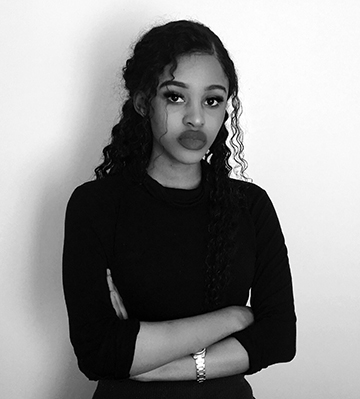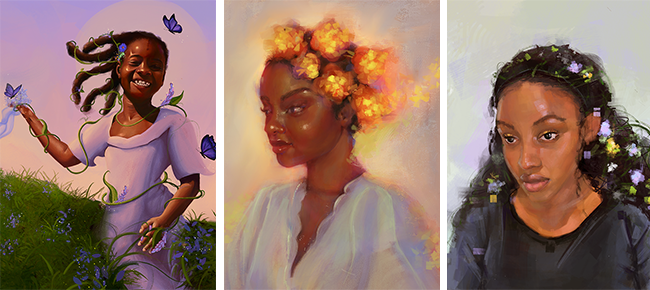News & Events
Her impactful art gives black women a voice

Lethabo Huma
The reserved, talented, and creative digital artist, Lethabo Huma, sees art as a personal craft that she uses as a personal diary and escapism from reality. Huma is pursuing a Bachelor of Arts in Visual Multimedia Arts at Unisa in the College of Human Sciences. Her art, which expresses her thoughts and emotions around continental issues facing women, is so unique that she is one of only 40 artists globally who have been selected to be part of the Time Magazine’s ‘Building a better future’ project.
“I love being involved in anything that is creative, it does not have to be drawing,” she says. “I am passionate about art that helps to express emotions. I use my work to speak to the world. I do not enjoy expressing myself verbally, so I use art as my tool of expression. For me, it is a safe space to be myself and do storytelling.”
Huma also sees her art as a voice for women, especially black women, and acknowledges that they have it tough. “Women are powerful, magnificent, and magical,” she says, “but the way black women are treated in the world is sad, dismissive and cruel. My work validates, especially to this target, that it is okay to look the way you do, there is nothing wrong with your identity and physique. It is also okay to be yourself and feel the way you do.”
She feels that black women do not get enough, if at all, validation from the world. “A little bit of validation is important for our mental and emotional growth. As women, it is important that we compliment, help, and support each other in the smallest ways we can,” she continues. “The best way to fight and push yourself against criticism, is to block out the negative noise and to not compromise who you are. It is important to be confident, so if you have to fake it until you make it, do so because you are worth it.”

Some of Lethabo Huma's creative artwork
Making an international impression
Speaking about the Time Magazine ‘Building a better future’ project, Huma says the international magazine gathered artists to sell their digital artwork as non-fungible tokens (NFTs) on their website. The magazine launched the project in September this year as Time Pieces, a new NFT community initiative. “I was nominated by a talented visual artist, Micah Johnson,” she says. “I was one of the 40 artists tasked to create artwork around what building a better future meant.”
She remarks: “My focus was on protecting black girls and creating safe spaces for them to express themselves. When I got the brief, I had a conversation with the president of Time Magazine, Keith Grossman, who told me that his daughter asked him if woman can ever be presidents. That greatly inspired my art piece.” Huma reiterates that it is important for girls to know that they can achieve whatever they put their minds to, especially black girls as the world can be dismissive and cruel towards growing up. “We need to nurture the emotional, spiritual and mental wellbeing of children, as that can shape how they see themselves and the world,” she says.
‘Unisa does it best for me’
Huma was initially a self-taught artist, and when she started doing art professionally she decided to register at a higher education institution. She states: “I decided to register at Unisa to improve my skills and learn more. I also saw it as an opportunity to fill the fundamental and creative gaps in my career. It is very important as an artist, and in general, to keep learning and finding ways to improve your craft.”
Huma says that she has learnt a lot from her qualification, and can now focus her energy on how to express her work and being more creative. “On a personal level, I have learnt not to be afraid to try new things,” she says. “Thanks to the workshops conducted by Unisa I can now stand in front of people and present my work, which can be nerve-racking. They have helped me to push myself even in uncomfortable situations, own up to and share my work, and accept constructive criticism.”
According to Huma, Unisa, as an open and distance e-learning (ODeL) institution, makes it easy for her to manage her work and career. “I feel that Unisa does it best as an ODeL university,” she says. “My mother is a Unisa alumna, so through her experience, I knew that Unisa would work for me. Unisa is convenient, and I can choose the number of modules that I can handle for the year. I would, therefore, recommend the institution to others, especially artists.”
Huma encourages students to stay focused during their studies, especially now during the examination period. She concludes: “There is power in self-discipline, and remember that everything has a start and a finish, so give it your all! You will feel more powerful, brave, and proud once you have achieved your goals.”
Huma’s work and updates about the project can be followed on Twitter: @lethabohuma and Instagram: @lethabohuma_art.
*By Nancy Legodi, Acting Journalist, Department of Institutional Advancement
** Images were supplied by the interviewee.
Publish date: 2021-11-08 00:00:00.0

